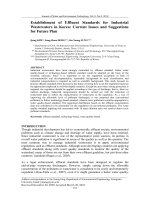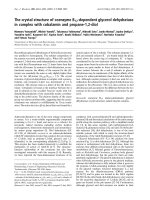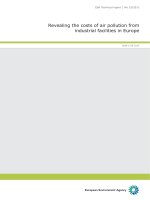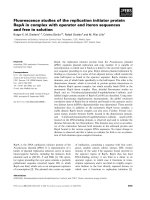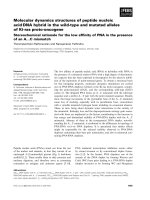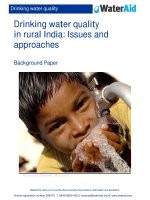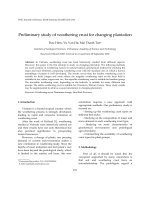Establishment of Effluent Standards for Industrial Wastewaters in Korea: Current Issues and Suggestions for Future Plan
Bạn đang xem bản rút gọn của tài liệu. Xem và tải ngay bản đầy đủ của tài liệu tại đây (293.04 KB, 15 trang )
Journal of Water and Environment Technology, Vol. 8, No.3, 2010
Address correspondence to Jin-Young Jung, Department of Environmental Engineering, Yeungnam
University, Email:
Received December 30, 2009, Accepted March 30, 2010.
- 151 -
Establishment of Effluent Standards for Industrial
Wastewaters in Korea: Current Issues and Suggestions
for Future Plan
Ijung KIM*, Sung-Hoon HONG**, Jin-Young JUNG***
* Department of Civil, Architectural and Environmental Engineering, University of Texas at
Austin,1 University Station, Austin, Texas, U.S.A.
** Environment Division, Korea Institute of Science and Technology, 39-1 Hawolgok-Dong,
Seongbuk-Gu, Seoul 136-791, Republic of Korea
*** Department of Environmental Engineering, Yeungnam University, 214-1 Dae-Dong,
Gyeongsan-Si, Gyeongsangbuk-Do 712-749, Republic of Korea
ABSTRACT
Industrial wastewaters have been strongly controlled by effluent standard. Either water
quality-based or technology-based effluent standard could be adopted on the basis of the
scientific rationale. Since it is important to set the regulation acceptable to both of
environmentalist and developmentalist, reasonable background in areal classification and
industrial categorization is required as well as scientific background. This study focused on
Korean effluent standards from the past to the future covering how to set the regulation based on
the approaches employed in well-developed countries. Except the area where strong protection is
required, the regulation should be applied according to the type of discharge, that is, direct or
indirect discharge. Industrial categorization should be carried out with the collection of
wastewater data to reflect the characteristics of wastewater in the regulation. As a way of
improving the allowable level of pollutant discharged, it was proposed that conventional
pollutants to follow technology-based standard, whereas toxic pollutants would be appropriate to
water quality-based standard. The lognormal distribution based on the effluent concentration
data was considered to be reasonable for the regulation of conventional pollutants. The water
quality standard implying risk assessment with 10 times dilution ratio was used to derive toxic
pollutant standards.
Keywords: effluent standard, technology-based, water quality-based.
INTRODUCTION
Though industrial development has led to economically affluent society, environmental
problems such as climate change and shortage of water supply, have been returned.
Since industrial wastewater is one of the representative point sources, its portion in
overall water pollution is significant in terms of the quality as well as the quantity. The
most common way to manage industrial wastewater is to apply environmental
regulations such as effluent standards. Although most developing countries are applying
effluent standards along with water quality standards to monitor the quality of the
watershed, many of those are not from their own effluent guideline, but just from other
countries’ standards (Ragas et al., 2005).
As a legal enforcement, effluent standards have been designed to regulate the
end-of-pipe wastewater dischargers. However, simply cutting down the allowable
concentration of the pollutants in wastewater is considered to be costly and temporarily
expedient (Abou-Elela et al., 2007), even if it might guarantee a better water quality.
Journal of Water and Environment Technology, Vol. 8, No.3, 2010
- 152 -
Therefore, the regulations are required to be reviewed regularly to achieve a consented
control and to show continuously changing situations. In the case of U.S., the
scheduling and implementing of annual review for the effluent standard are imposed by
the Environmental Protection Agency (EPA). As stringent regulations could be applied
by the technological advancement in wastewater technology (Jaffe et al., 2002), the
revision of the effluent standards is facing new aspects in terms of treatability with
reasonable basis. Especially, Organisation for Economic Co-operation and Development
(OECD) has been encouraged to use the best available techniques to prevent water
pollution (OECD, 1999).
The regulation covers a complexity of various elements including discharging area, type
of discharge, and kind of industry. Therefore, the need for a simplified effluent guideline
has been suggested (De La O et al., 1994). By selecting critical variables to be
considered in setting effluent standards, effluent guidelines could be organized in a less
complicated form. This approach would be beneficial to other developing countries as
well.
In Korea, although the effluent standard went through several revisions, reasonable
basis of the regulation has not been established yet. As an effort of setting the regulation
based on treatability, it is required to collect wastewater data as much as possible. In this
study, the approach in setting the effluent standards with a limited data set obtained so
far according to the kind of pollutants and industries was investigated. This paper
focused on the current state of effluent standards in Korea and the considerations to be
used in revising effluent standards and the framework referring to the cases of
developed countries. The purpose of this study is to set up the acceptable level of
effluent standards with scientific basis and to suggest a direction of the effluent
guidelines which can make industrial point sources scattered all over the country gather
into public wastewater treatment plants, resulting in a better control of individual
wastewater dischargers.
METHODS
Bases of effluent standard
In general, water quality standard is set prior to effluent standard because the cleaner the
effluent, the cleaner would be the water systems. Water quality standard starts from
water quality criteria based on risk assessment. The United States EPA proposed the
process of setting water quality criteria concerning both human health (US EPA, 2000)
and aquatic life (US EPA, 1996). For human health, risk assessment is applied
differently according to the carcinogenicity of the pollutant. Reference dose is used as
an important parameter in the derivation of safe concentration in case of carcinogens,
whereas another concern on non-carcinogens is to evaluate the reference source
contribution. For aquatic life, the determination criteria are highly dependent on acute
and chronic toxicity data provided by an officially approved database system such as
Ecotox (US EPA, 2008). To get more reliable criteria, it is crucial to collect sufficient
data from various taxonomical groups such as fish, daphnia and algae. From the criteria
derived by risk assessment, water quality standards can be adjusted by the regional
classification, that is, the designated use of a specific watershed.
Journal of Water and Environment Technology, Vol. 8, No.3, 2010
- 153 -
After confirming the water quality standard, effluent standard can be set according to
dilution ratio, treatability, economic feasibility, and other factors. Two kinds of
approaches in setting effluent standard are water quality-based approach and
technology-based approach.
Water quality-based approach
The key components in water quality-based approach are water quality standards and
models. As mentioned above, the methodology to set the water quality standards
contains the principle of risk assessment. Scientific data of bio-assay rather than
industry data should be gathered. In risk assessment, acute and chronic toxicity can be
represented as LC
50
(median lethal concentration) / EC
50
(median effective
concentration) and NOEC (no observed effect concentration), respectively. The toxic
effect onto human and aquatic life is evaluated separately. Considering toxic effect and
data collection, this approach is better applied to toxic pollutants. Safety factor in the
range of 10-1,000 is used in EU (EU, 2000) and Australia (ANZECC, 2000). The
calculation of the water quality criteria is shown in equation (1).
50 50
LC , EC or NOEC
Water Quality Criteria =
Uncertainty factor (10~1,000)
Water quality standards are determined through the water quality criteria. In Korea,
water quality standards were set up by considering the drinking water standards and the
economical and technical availability. Because water quality standards express the
quantified level of water quality, appropriate selection of models can guarantee the
water quality-based effluent standard. According to the characteristics of watershed,
various models can be applied. The simplest model comes from the following equation
(Ross, 1994).
12 31 1
2
2
(F +F ) C -F C
C =
F
where, F
1
: upstream flow
F
2
: discharge flow
C
1
: concentration in upstream
C
2
: concentration in discharge (effluent standard)
C
3
: concentration in downstream (water quality standard)
Technology-based approach
Acknowledging the limitation of treatment technology, technology-based approach has
appeared in view of treatability. In developed countries such as US and EU countries,
technology-based approach was adopted as a feasible way in social, economical and
technical compromise (US EPA, 1996; EU, 1996). Technology-based approach is often
referred to as the best available technology (BAT) approach. This approach is being
used in the EU and US. What is important in BAT approach is the thorough analysis of
the industry including treatment facilities, as well as effluent characteristics. Though it
is desirable in long-term, it takes too much time and effort making it difficult to apply in
developing countries. Using the easily assessable data which is the concentration in the
effluent, the logical argument could be established by a statistical support. Statistical
approach (Wheatland, 1972) was found to be required in setting the effluent standards
(1)
(2)
-
Journal of Water and Environment Technology, Vol. 8, No.3, 2010
- 154 -
of a sewage treatment plant. Regression of the effluent data could be a key concept in
setting the effluent standards (Kahn and Rubin, 1989).
To derive the effluent standards by the technology-based approach, the effluent quality
from wastewater treatment should be monitored and recorded to be converted into a
concentration-frequency graph which can be assumed as a probability distribution such
as normal, lognormal or delta-lognormal distribution. Through statistical analysis,
effluent standard by technology-based approach is determined. In the US, lognormal
distribution or delta distribution which shows reasonably good fit to various effluent
data, has been used in the calculation of the effluent standard. The approach by effluent
data and statistical fitting can be used to suggest practical level of effluent standard
rather than the required one. The 95
th
percentile approach (Crain, 1995) has been used to
derive monthly average effluent standard in the US.
Combining both approaches can be a good solution to set the effluent standard in develo
ping countries (Ragas et al., 2005). Wherever Total Maximum Daily Loads (TMDL) is
established, the water quality-based approach employed by US EPA (US EPA ,
1991) can be applied. Although water quality-based approach is sufficient only to keep
the water quality standard, it can impose overburden with individual treatment facility,
even to economically infeasible level. Therefore, technology-based approach can be a c
omplement to water-quality based approach. The important concept of technology-base
d approach is to set the level of effluent standard so that the treatment facility can meet t
he regulation.
Each effluent standard derived from both approaches is compared to determine which
value or range is reasonable to satisfy water quality standard and technologically
feasible level. Unless the safety of water quality is guaranteed, the regulation could rely
on water-quality based approach with the benefit/cost analysis which helps the
decision-maker to predict the result of regulation (Arrow et al., 2008). Through social
compliance to the degree which the stakeholders can agree with, effluent standard can
be finally confirmed.
So far, effluent standard in Korea is considered to be subordinate to water quality
standard. However, it is required to evaluate effluent standard as an independent
regulation and to revise it based on the methods employed in well-developed countries.
RESULTS AND DISCUSSION
Overview of effluent standard in Korea
Once a pollutant was included in the effluent standard, the allowable concentration
stated remained constant for more than 20 years with the exception of a few cases. The
main reason is that there was no basis of effluent standard, resulting in just following
other countries’ cases. In getting the numeric value to control the amount of pollutant
discharged, it is difficult to avoid being controversial due to various viewpoints of
stakeholders. In brief, it can be described as a debate between protection and
development; an effort to get clean and safe water and a desire to reach an economically
developed society. Above all, sustainability can be the conceptual solution to manage it
(Costanza et al., 1991), covering both ecological and economic aspects. Also, science as
Journal of Water and Environment Technology, Vol. 8, No.3, 2010
- 155 -
an advanced support of policy-making is required to involve the public sector (Cortner,
2000).
Pollutants regulated in effluent standard
The concept of effluent standard in Korea emerged in the middle of 1960s with the enfo
rced ordinance of pollution prevention. Although it has been revised continuously, the re
sults were just an increase in the number of pollutants and a decrease in the level of allo
wable concentration, mostly depending on chemical analyses (Choi et al., 2004). The nu
mber of pollutants regulated under effluent standards was initially 7, and now it increase
d to 32 (Table 1). It seems that the range of control was greatly increased, yet it is still s
mall when compared to the number of pollutants regulated in well-developed countries l
ike Japan which regulates 42 pollutants and the U.S. which has 65 toxic pollutants to be
controlled. Because new pollutants in Korea are assessed and selectively included into e
ffluent standards by framework for classifying toxic substances in water environment (B
ae et al., 2007), it is expected that the number of pollutants would be increased up to the
level of well-developed countries. The pollutants recently included can be classified int
o a group defined as toxic pollutants in U.S (US NARA, 2007).
Especially, ecotoxicity which is the same parameter as the whole effluent toxicity (WET
) in Korea has been adopted to unlimitedly manage increasing pollutants with the advan
cement of analytical tools. The WET regulation checks whether more than 50% of organ
isms (fish, daphnia, algae and others) under toxicity test survive or not when they are dir
ectly introduced to the discharged wastewater. Wastewater is directly applied in protecte
d area, while twice diluted wastewater is used in normal areas, as a tool to investigate th
e total toxicity on human health and aquatic lives. Now it can be easily found that WET,
as a complementary tool to chemical approach of the regulation, already took a part of
effluent regulation with legal enforcement in other countries (Environment Agency,
2006; Germany, 2004).
Nowadays, 32 pollutants (Table 1) officially regulated in Korea can be classified in the f
ollowing groups.
Conventional pollutants
Biochemical oxygen demand (BOD), chemical oxygen demand (COD), suspended
solids (SS), total nitrogen (TN), and total phosphorus (TP) are classified in the
conventional pollutants. They are the most representative and common groups in water
pollutants. Hence, they have been widely used in water quality index, and it is easy to
accumulate the effluent data of this group.
Toxic pollutants
Toxic pollutants are the chemicals which can cause fatal threat to human and
eco-system even at low concentration. They are categorized as priority substances (EU,
2000) or toxic pollutants (Khan and Rubin, 1989). In Korea, 22 pollutants among 32 are
included in the toxic group. This group is relatively difficult to analyze in general, and is
expected to increase in number due to the advancement of analysis. It is required to pay
attention to select pollutant regulated according to industry.
Other pollutants
The rest of the pollutants are grouped as other pollutants. The pollutants under this
group contain pH, temperature, color, total coliform and ecotoxicity. They are not
Journal of Water and Environment Technology, Vol. 8, No.3, 2010
- 156 -
expressed in mg/L, unlike the other specific chemical compounds. As the universal
characteristics appeared in almost every industrial effluent to some extent, other
pollutants could also be applied to all of the industries except color. Color has been
reported to appear uniquely high in specific industries such as dyeing and textile
industry. In this study, this group was not considered to be changed in setting the
effluent standards.
Table 1 - Pollutants regulated under the effluent standards in Korea (Ministry of
Government Legislation in Korea, 2009).
Areal classification in effluent standard
According to the beneficial use of the watershed where wastewater is discharged, the
level of allowable amount of pollutant can be set. For example, the area where strong
protection is required such as drinking water, has normally strict effluent standards
specialized for its limited area. Moreover, aside from national standards, effluent
standards can be applied differently by the local government, making the application
more flexible to specific conditions. While the protected area was established so far,
there has been a little concern on local standard. Therefore, once national standard is set,
it is applied all over the nation. Now, four areas are defined in effluent standard;
